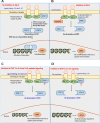SARS-CoV-2 mediated lung inflammatory responses in host: targeting the cytokine storm for therapeutic interventions
- PMID: 33064288
- PMCID: PMC7563911
- DOI: 10.1007/s11010-020-03935-z
SARS-CoV-2 mediated lung inflammatory responses in host: targeting the cytokine storm for therapeutic interventions
Abstract
The recent exposure of novel coronavirus strain, severe acute respiratory syndrome (SARS-CoV-2) has spread to different countries at an alarming rate. Faster transmission rate and genetic modifications have provoked scientists to search for an immediate solution. With an increasing death rate, it becomes important to throw some light on the life cycle of the virus and its associated pathogenesis in the form of lung inflammation through cytokine storm (CS) production. This paper highlights the different stages of viral-mediated inflammatory responses in the host respiratory system. Previously, known anti-inflammatory drugs and therapeutic strategies that might show potential in controlling the CS of Coronavirus disease-2019 (COVID-19) is also mentioned in this study. Our critical analysis provides insights into the inflammation cycle induced in the lungs by early virus replication, downregulation and shedding of angiotensin-converting enzyme 2 (ACE2), and in the CS production. Identification of suitable targets within the inflammatory pathways for devising the therapeutic strategies useful in controlling the prognosis of COVID-19 finds a special mention in this article. However, antibody-dependent enhancement is the key aspect to consider before testing any drug/compound for therapeutic purposes. Our in-depth analysis would provide similarities and differences between the inflammatory responses induced by SARS-CoV and SARS-CoV-2, providing an excellent avenue to further look at how earlier outbreaks of coronaviruses were controlled and where new steps are required?
Keywords: And antibody-dependent enhancement; COVID-19; Cytokine storm; Lung inflammation; SARS-CoV-2; Therapeutic strategies.
Conflict of interest statement
The authors declare no conflict of interest.
Figures




Similar articles
-
Effects of sEH inhibition on the eicosanoid and cytokine storms in SARS-CoV-2-infected mice.FASEB J. 2024 May 31;38(10):e23692. doi: 10.1096/fj.202302202RR. FASEB J. 2024. PMID: 38786655
-
SARS-CoV-2 multifaceted interaction with human host. Part I: What we have learnt and done so far, and the still unknown realities.IUBMB Life. 2020 Nov;72(11):2313-2330. doi: 10.1002/iub.2380. Epub 2020 Sep 12. IUBMB Life. 2020. PMID: 32918855 Review.
-
Promising drug repurposing approach targeted for cytokine storm implicated in SARS-CoV-2 complications.Immunopharmacol Immunotoxicol. 2021 Aug;43(4):395-409. doi: 10.1080/08923973.2021.1931302. Epub 2021 May 31. Immunopharmacol Immunotoxicol. 2021. PMID: 34057871 Free PMC article. Review.
-
Janus kinase signaling as risk factor and therapeutic target for severe SARS-CoV-2 infection.Eur J Immunol. 2021 May;51(5):1071-1075. doi: 10.1002/eji.202149173. Epub 2021 Mar 22. Eur J Immunol. 2021. PMID: 33675065 Free PMC article. Review.
-
Drugs, Metabolites, and Lung Accumulating Small Lysosomotropic Molecules: Multiple Targeting Impedes SARS-CoV-2 Infection and Progress to COVID-19.Int J Mol Sci. 2021 Feb 11;22(4):1797. doi: 10.3390/ijms22041797. Int J Mol Sci. 2021. PMID: 33670304 Free PMC article.
Cited by
-
Therapeutic approaches for SARS-CoV-2 infection.Methods. 2021 Nov;195:29-43. doi: 10.1016/j.ymeth.2021.04.026. Epub 2021 May 5. Methods. 2021. PMID: 33962011 Free PMC article. Review.
-
Features of Pathobiology and Clinical Translation of Approved Treatments for Coronavirus Disease 2019.Intervirology. 2022;65(3):119-133. doi: 10.1159/000520234. Epub 2021 Oct 25. Intervirology. 2022. PMID: 34666335 Free PMC article. Review.
-
Mesenchymal stem cells and their derived exosomes for the treatment of COVID-19.World J Stem Cells. 2024 Apr 26;16(4):353-374. doi: 10.4252/wjsc.v16.i4.353. World J Stem Cells. 2024. PMID: 38690515 Free PMC article. Review.
-
Interleukin 6, soluble interleukin 2 receptor alpha (CD25), monocyte colony-stimulating factor, and hepatocyte growth factor linked with systemic hyperinflammation, innate immunity hyperactivation, and organ damage in COVID-19 pneumonia.Cytokine. 2021 Apr;140:155438. doi: 10.1016/j.cyto.2021.155438. Epub 2021 Jan 15. Cytokine. 2021. PMID: 33493861 Free PMC article.
-
Guidelines and Safety Considerations in the Laboratory Diagnosis of SARS-CoV-2 Infection: A Prerequisite Study for Health Professionals.Risk Manag Healthc Policy. 2021 Feb 3;14:379-389. doi: 10.2147/RMHP.S284473. eCollection 2021. Risk Manag Healthc Policy. 2021. PMID: 33568956 Free PMC article. Review.
References
Publication types
MeSH terms
Substances
Grants and funding
LinkOut - more resources
Full Text Sources
Other Literature Sources
Miscellaneous

